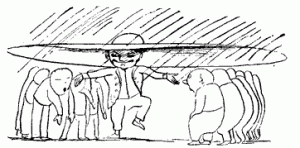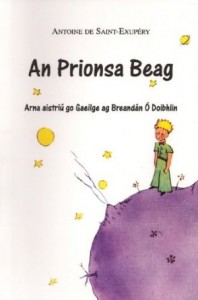Oh, Man! ‘Fear,’ ‘Fir,’ ‘Fhir,’ and ‘bhFear,’ (How to say ‘man’ and ‘men’ in Irish) Posted by róislín on Jan 9, 2014 in Irish Language
(le Róislín)

Grúpa fear gan hataí agus fear amháin a bhfuil hata air. Nach mór é hata an fhir seo! Níl hataí ar na fir eile. Cá bhfuil hataí na bhfear sin?
Since Nollaig na mBan on January 6th gave us the opportunity to discuss the Irish word for ‘woman,’ we might as well follow up with the word for ‘man.’
First, let me clarify that this blog will discuss ‘man’ (fear) as opposed to woman (bean), not “man” as opposed to the following:
plants (plandaí)
animals (ainmhithe)
human holograms (holograim dhaonna)
extraterrestrials (eachtardhomhandaigh)
supernatural creatures (neacha osnádúrtha mar abhaic, hobaid, agus leipreacháin) or
other sentient beings (neacha mothaitheacha) such as the hungry crystalline entity (beith chriostalach ocrach) san eipeasóid “Silicon Avatar” (TNG) or the shimmering mass of energy (meall crithlonrach fuinnimh) that rescues the spaceship-wrecked Zefram Cochrane san eipeasóid “Metamorphosis” (TOS) in Star Trek.
‘Man’ in these philosophical and existential contexts would be “duine,” a cousin of the Welsh word “dyn.”
So what are the forms of the word ‘fear‘ (“man,” in the biological sense)? It’s a first- declension noun, masculine by default, and follows quite a regular pattern:
fear [fær, with a very slight “y” quality to the “f”; the vowel sound is as in “Harry” or “Faraday,” not as in “Mary” or “far,” or the English chance-lookalike, “fear,” as in “fear / fright”], man. Sampla: Is fear é Tarzan agus is bean í Jane, ach ní síota é Cheeta — is simpeansaí é Cheeta.
an fear, the man. Sampla: Tá an fear anseo.
fir [firzh, with the buzzy slender “r” not typically found in English but like the “r” of the Czech name “Jiří“], of a man; hata fir, a man’s hat. Sampla: Nuair a bhí sé sé bliana d’aois, línigh aithriseoir an leabhair An Prionsa Beag nathair a raibh eilifint á díleá aici. Bhí cuma hata fir ar an nathair sa phictiúr mar bhí an eilifint i mbolg na nathrach — ceann agus ruball na nathrach mar dhuilleog an hata, ceann agus cabhail na heilifinte mar thóin (!) an hata (“crown of the hat” a deirtear i mBéarla). B’fhéidir gur cuimhin leat an pictiúr clúiteach i leagan éigin den leabhar (an bunleagan: Le Petit Prince agus leaganacha eile: The Little Prince, Der Kleine Prinz, El Principito, Y Tywysog Bach, Ar Priñs Bihan, srl.)
an fhir [un irzh, with the “fh” silent], of the man. Sampla: Seo hata an fhir.
fir, men. Sampla: Níl fir ina gcónaí i “Herland,” ainm tíre san úrscéal útóipeach Herland a scríobh Charlotte Perkins Gilman i 1915.
na fir, the men. Sampla: “Sláinte chuig na fir is go maire na mná go deo.” (cuspa sláinte traidisiúnta)
fear, of men. Sampla: hataí fear, men’s hats
na bhfear [nuh vær], of the men. Sampla: “Sláinte na bhfear is go maire na mná go deo!” Another version of the same toast given above, this time using the phrasing “the health of the men” instead of “health to the men.”
And, for good measure, another example of “na bhfear“: “Seomra na bhFear” (Men’s Room, i.e. men’s restroom, “teach an asail,” or call it what you will)
You might also encounter:
i bhfear, in a man
i bhfir, in men, admittedly not real widely used but it did appear in a previous blog in this series, “No, this blog isn’t going to be about toircheas fireann (à la Trip Tucker and the Xyrillians in Star Trek: Enterprise, “The Unexpected”). Nor will it be about capaill mhara or snáthaidí mara or the possibilities of toirchis eachtópacha i bhfir as postulated in our homeworld or as speculated about i bhficsean eolaíoch.” (https://blogs.transparent.com/irish/when-is-a-mathair-not-a-mother-literally-that-is/, 7 Bealtaine 2013)
Bhuel, that’s it for equal opportunity noun paradigms for now. Slán go dtí an chéad uair eile, a fheara agus a mhná! Úúps, sin foirm eile fós: “a fheara” [uh ÆR-uh, silent “fh”]” that’s the traditional vocative plural form, for direct address. – Róislín
Cúpla nasc shuimiúla:
An Prionsa Beag, ar fáil ó www.readireland.ie/ agus http://www.litriocht.com/shop/index.php#.UtMDXfRDtrk, and other major online bookdealers.
Seo an méid a deir an t-aithriseoir faoina eispéireas le líníocht: “Thaispeáin mé an sárshaothar seo liom do na daoine móra agus d’fhiafraigh mé díbh ar chuir mo phictiúr eagla orthu.
“D’fhreagair siad: ‘Cén fáth a gcuirfeadh hata [.i. “hata fir” mar atá sa chur síos thuas – Róislín] eagla orm?’ Ní hata a bhí i mo phictiúr. Pictiúr ab ea é de nathair boa agus eilifint á díleá aici. Mar sin rinne mé pictiúr den taobh istigh de nathair boa, sa chaoi go bhféadfadh na daoine móra é a thuiscint. Bíonn míniú de dhíth orthu i gcónaí. … Dúirt na daoine móra na pictiúir de nathracha boa, ar oscailt nó dúnta, a fhágáil i leataobh, agus luí isteach ina áit sin le mo cheachtanna tíreolais, stair [sic], uimhríochta agus gramadaí.” And thereby hangs a tale but one far beyond the scope of this blog. Maidir le ruball na heilifinte boichte, sin scéal / tale / tail eile ar fad! É díleáite le fada an lá, is dócha. Ar aon chaoi, The Little Prince is one of my all-time favorite books, and I was delighted when the Irish version appeared in 1997, republished by Read Ireland in 2007.
Gluaisín beag don athfhriotal: sárshaothar, major work; díleá, digesting; go bhféadfadh, would be able; míniú, explanation; i leataobh, aside
teach an asail: http://www.spailpin.com/en/language-more/gifts/the-donkey-s-house-teach-an-asail-wooden-sign-detail (Yes, you can buy a handmade wooden sign saying “teach an asail,” in a choice of three colors, from “Spailpín,” located in An Spidéal, in the Conamara Gaeltacht.

Build vocabulary, practice pronunciation, and more with Transparent Language Online. Available anytime, anywhere, on any device.





Leave a comment: